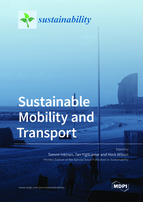Possibility of a Solution of the Sustainability of Transport and Mobility with the Application of Discrete Computer Simulation—A Case Study
Round 1
Reviewer 1 Report
The paper is focused on an example of a solution for the sustainability of transport and mobility with the application of discrete computer simulation. The obtained results from the realized simulation were complemented with the selected multi-criteria decision-making method, namely the analytic hierarchy process (AHP) method. The result showed the solution reduced the length of congestion in almost all directions, with a maximum shortening of 69m and a shortening of the average delay by 26s compared to the current state. This paper discusses an interesting problem, and the structure is good.
1) Is this work based on a specific software program with the graphic interface? If yes, please make the details (including the version information) clear.
2) Why in this paper, only the information provided by experts is used. In this case, the work performance depends on different experts.
3) A symbol table is needed to explain all used notations for easy understanding.
4) The related work is not organized well, it is better to categorize the related work in a new created section.
5) For the evaluation, describe more details (e.g., the choosing reasons) of the tested datasets and other solutions, and the machine/platform configuration can be introduced.
6) Remove all the typographic errors. Carefully check throughout the paper, and why Section 2.1 is repeated. Replace blurry figures with clear vector ones.
7) Make the References more comprehensive, besides the transportation simulation, the similar work may can be applied in some other promising scenarios (e.g., Big Data or other IoT systems). If the above related work can be discussed, it can strongly improve the research significance. For the improvement, the following papers can be considered to make the references more comprehensive.
M. Waqas, S. Tu, S. U. Rehman, Z. Halim, S. Anwar et al., “Authentication of vehicles and road side units in intelligent transportation system,” Computers, Materials & Continua, vol. 64, no. 1, pp. 359–371, 2020.
W. Liu, Y. Tang, F. Yang, C. Zhang and D. Cao, “Internet of things based solutions for transport network vulnerability assessment in intelligent transportation systems,” Computers, Materials & Continua, vol. 65, no. 3, pp. 2511–2527, 2020.
B. Yan, “Improvement of the economic management system based on the publicity of railway transportation products,” Intelligent Automation & Soft Computing, vol. 26, no.3, pp. 539–547, 2020.
J. Liu, X. Kang, C. Dong and F. Zhang, “Simulation of real‐time path planning for large‐scale transportation network using parallel computation,” Intelligent Automation & Soft Computing, vol. 25, no.1, pp. 65–77, 2019.
J. Wang, Y. Yang, T. Wang, R. Sherratt, J. Zhang. Big Data Service Architecture: A Survey. Journal of Internet Technology, 2020, 21(2): 393-405
H. Gao, W. Huang and X. Yang, “Applying probabilistic model checking to path planning in an intelligent transportation system using mobility trajectories and their statistical data,” Intelligent Automation & Soft Computing, vol. 25, no.3, pp. 547–559, 2019.
J. Zhang, S. Zhong, T. Wang, H.-C. Chao, J. Wang. Blockchain-Based Systems and Applications: A Survey. Journal of Internet Technology, 2020, 21(1): 1-14
T. S. Dillon, Y. P. Chen, E. Chang, M. Mohania and V. Ramakonar, “Conjoint knowledge discovery utilizing data and content with applications in business, bio-medicine, transport logistics and electrical power systems,” Computer Systems Science and Engineering, vol. 35, no.5, pp. 321–334, 2020.
Author Response
Please see the attachment.
Author Response File: ![]() Author Response.pdf
Author Response.pdf
Reviewer 2 Report
The paper is very well-written and clearly set out. The case for using computing simulation and AHP is well made in this specific example. However, it is difficult to see the wider contribution of the paper to the academic field. The paper looks at a very specific example and fails to demonstrate the applicability at a broader level. I believe this could be achieved with a strong literature review, and deeper discussion of the wider impacts, including policy impacts and impacts on sustainability.
Author Response
Please see the attachment.
Author Response File: ![]() Author Response.pdf
Author Response.pdf
Round 2
Reviewer 1 Report
Authors well addressed all the concerns on this work. It is acceptable for publication with high quality.
Reviewer 2 Report
The issues have been succinctly and clearly dealt with and the paper is much improved





